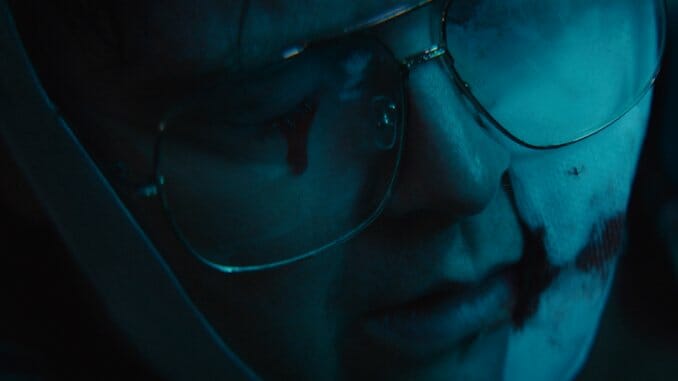Devereux Milburn Makes a Meal of His Debut with Horror Honeydew

Cannibalism shouldn’t be funny. Consuming human flesh in one of humanity’s biggest taboos, as the human body is rendered into nothing but a slab of meat to be consumed. No longer are we separated from animals as our flesh becomes indistinguishable from a cut of beef or pork. And yet, Devereux Milburn makes the dehumanizing act into deeply uncomfortable, pitch-black horror/comedy in his feature film debut, Honeydew. He somehow makes you unleash your best nervous laugh as you join his characters on a journey through a very specific brand of hell that I would secretly wish upon my worst enemies.
Milburn wastes no time establishing Honeydew’s deeply unsettling tone through close-ups of wheat and narration by an uncomfortably self-assured child talking about sacrificing the body for God. As she delivers her strange sermon, the camera switches between close-ups of her mouth and her meal as she devours a plate covered in steak, ketchup and egg yolks—a nauseating combination when viewed from above, as if it were a perverse episode of Chef’s Table. Importantly, every shot of and word from this young girl’s mouth lays out a set of clues that tease the horrifying events to come.
Meanwhile, couple Sam (Sawyer Spielberg, son of Steven, in his first real role) and Rylie (Malin Barr) are traveling to rural New England as part of Rylie’s PhD research on sordico, a fungal infection that affects wheat crops. It also affects both cows and humans, as they consume the infected wheat—plus, it can be transmitted through the cow’s meat. Side effects include gangrene and insanity. Now those establishing shots start to make sense.
After a bizarre conversation with an old man on a tractor and a suffering a broken-down car, they happen upon Karen’s (Barbara Kingsley) house and ask for some assistance. She graciously offers help and lets them in. As Karen forcibly cooks them dinner, a middle-aged man sits with a bandage wrapped around his head, drinking milk through a crazy straw, watching old Popeye cartoons and not uttering a single word. He is barely acknowledged and treated by Karen as if he’s wallpaper. Something is deeply wrong in this house, and Sam and Rylie are unfortunately about to find out what it is.
In fact, everything about Honeydew feels off, as if you’re always missing one piece of crucial information to completely understand what’s going on—and Milburn wants it that way. The purposefully disjointed script creates a tone of confusion and unease right off the bat, while also establishing Milburn’s twisted sense of humor: Rylie watches old science videos on her phone about wheat sexuality while Sam practices an audition monologue in a gas station bathroom. All of these seemingly disparate elements come together when they eventually share the same physical space in their car. But, they still exist in their own private spheres—emphasized by the use of split screen. Rylie’s video and Sam’s voice overlap as images of both their concentrated faces and the wheat fields passing their car appear on screen. The droning voice of the British voiceover clashing with Sam’s screaming recitations are so jarring it’s funny; it makes you stop and think, am I watching the right movie? This marks the beginning of a sensory cacophony, which starts quietly and continues to build to an outright shriek by the film’s end.
-

-

-

-

-

-

-

-

-

-

-

-

-

-

-

-

-

-

-

-

-

-

-

-

-

-

-

-

-

-

-

-

-

-

-

-

-

-

-

-








































